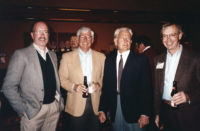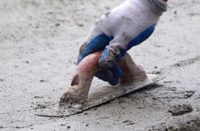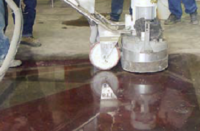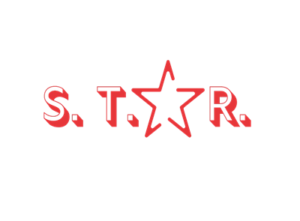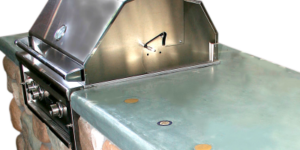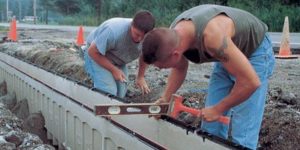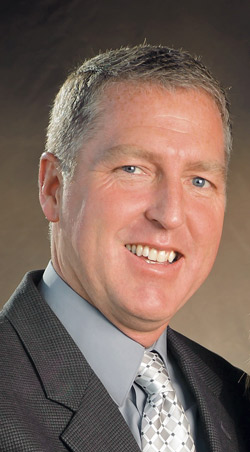 Todd Scharich was recently appointed decorative concrete specialist for the American Society of Concrete Contractors and its Decorative Concrete Council. The ASCC already had a concrete hotline, but with Scharich aboard since October 2012, it now has a dedicated Decorative Concrete Hotline available to members on a 24/7 basis. We talked with Scharich about his new role with the ASCC and how he hopes to better serve the concrete community.
Todd Scharich was recently appointed decorative concrete specialist for the American Society of Concrete Contractors and its Decorative Concrete Council. The ASCC already had a concrete hotline, but with Scharich aboard since October 2012, it now has a dedicated Decorative Concrete Hotline available to members on a 24/7 basis. We talked with Scharich about his new role with the ASCC and how he hopes to better serve the concrete community.
Todd, what’s your background and how did it prepare you to provide this service to contractors?
I guess I’m a good resource manager and facilitator. I’ve been in decorative concrete for 15 years. Initially, I was running a well-established family masonry business, but we became known for our decorative concrete work in the late 1990s. We were doing primarily colored stamped concrete, mostly smaller commercial and residential projects. We took on a few projects — what were for us monster jobs — of 50,000 square feet, and that gave me an opportunity to become a distributor of the materials.
In 2001 we created a distribution company that specializes in integral color that is sold through ready-mix companies primarily in Michigan.
In that kind of situation, you not only learn how to do the projects but also how to make them profitable. So, I’m not just a contractor who really knows the ins and outs of a load of concrete, I also know a lot about the budgeting of it, the business side of it, how to put the whole puzzle together.
How do you see your new role at the ASCC?
There are really three key pieces to the position.
The first is the technical hotline. On a daily basis, I get emails and phone calls from people around the country. Some are very technical in nature — installation problems with coatings, etc. The other half are business questions: owner-contractor disputes, risk management (warranty-type issues).
The second service is to provide technical information that is unique to the decorative concrete industry. Here’s an example. A few years ago, we had a lot of sealant failures. ASCC convened a forum of sealer manufacturers, distributors, and contractors, and we sat down in a room for a day and a half and discussed what was going on, why people were seeing so many failures. It turned out that the sealer manufacturers were forced to make changes in their formulations due to VOC laws, and they made those changes, but didn’t really communicate them down to the end user.
What contractors need to realize is that now, it’s crucial to put down sealers according to the directions — very thin, under very defined temperatures or conditions. Otherwise you’re going to have problems. The old “this is the way I’ve always done it” attitude is just not going to work with the new formulations. So, it was truly a communications problem.
The ASCC response to that is an example of my second role. We created a document, a 50-page book that’s about to be published, the Sealer Selection and Application Guide, that addresses sealer selection, application and troubleshooting. A, it’s picture laden for troubleshooting, so you can compare what you see to the pictures. B, it will tell you how to remedy it. And sometimes, C, it will include information on how to prevent it from happening again. I expect to see it available soon online and at trade shows.
So, my second role is to provide education on timely issues in a timely manner. Part of that is to create technical references, whether it be forums, classes or documents, that define guidelines for our industry.
Our industry is filled with unrealistic expectations. Some of the hotline calls I get are about disputes, where “the owner thinks I should do this and I can’t do it.” It’s so undefined that there are unreasonable expectations. Unless it’s defined well, you’re setting up for a job-gone-bad issue.
One of the things I’m working on now, a hot thing on my table, is a series of 12 to 24 documents, one to two pages each, called Best Practices of Decorative Concrete. These are documents that will try to establish those practices and set expectations correctly, to help keep disputes to a minimum. Our industry doesn’t have a guidebook. There are no ACI standards for decorative concrete to reference.
I’ve sat in court cases as an expert witness on decorative concrete, and a lawyer would ask what’s acceptable and what’s not, and I would have to reference a magazine article. We’re seeking to come up with guidelines: surface crusting, surface preparation requirements, things like that. We want to cover them in a document that doesn’t take years to produce, but will provide good information to help our contractors out and tell them what’s expected of them as well.
The third aspect of my position is to grow the Decorative Concrete Council. I think the Council is poised to be the voice of decorative concrete. There’s going to be a need for training and/or certification standards, or a specification book for decorative concrete.
ASCC is like a group of top-notch contractors. We want to make it a club that more people will want to join. People will see that our members are the ones creating superior work and winning awards, and because those companies are willing to turn around and share the information that got them those awards, share it with any contractor who becomes a member, people will want to become part of that.
What questions are you answering most frequently?
A lot of the questions are involved with the use of multiple products. Contractors are being asked to combine textures, stains and coatings that may not be traditionally be used together. Many architects are looking for decorative concrete applications that stretch the products’ abilities.
Another recent trend is people asking for marketing ideas. They’re asking, what niches are we seeing? Are they being covered? Or is there a dominant player? What does it take to get involved in that area? Companies are looking for insight to take them out of the routine work that has them bidding up against dozens of other contractors.
How do you get answers to questions that stump you?
I’d like to say I can answer all those questions immediately, but normally I can’t. I turn around and talk to a contractor I know, and I try to put the pieces together. About half the time, I know I’m going to turn around and call other members of the ASCC.
Ward Malisch, who is technical director for ASCC on regular concrete, has always been one of my first call resources. I think one of the reasons I became the decorative hotline is because of Ward. He used to get calls about decorative work and would often turn to me. I still look to people like him for answers on some of those straight-up concrete issues.
Will it be strictly phone and email, or will you reach into Twitter, etc?
Members of ASCC have an internal email question-and-answer forum, which is one of the best benefits of ASCC. People like myself or other contractors will throw out real-world responses to questions. “I’ve done this with this before, and that works.” We are always considering ways to expand our access with our Facebook page, or possibly in the future with LinkedIn.
What do you see are trends in decorative concrete?
At this very moment, I think the trend is metallic and micas. I see the use of additives in epoxy to make it look like a metallic finish, the use of micas that produce some kind of glitter in overlayments, even glow-in-the dark technology for safety purposes. I think those modifications are adding a little bit of flashiness to existing products. Polishing is definitely on a huge growth line — it has been for a few years and we’ll see that continue — but I think the additives are the hot item at the moment.
In addition I think that green, LEED-related products and health-related products are coming up more over the horizon. Consider that, instead of tile and carpet, we’re offering solid-surface, easy-to-clean floors. Light-colored concrete instead of dark asphalt is another environmentally oriented choice.
Where will our readers expect to see you?
I’ve spoken at World of Concrete for 10 straight years. I’m always at the Concrete Decor Show. I’m speaking on decorative topics at the ASCC meeting this fall in Columbus. I try to participate in every major decorative concrete function there is. I frequently do trainings with contractors and give presentations to architects and engineers. I love showing off the photos of our industry’s work.
Todd can be reached at [email protected] or (888) 483-5288, the Decorative Concrete Hotline.
